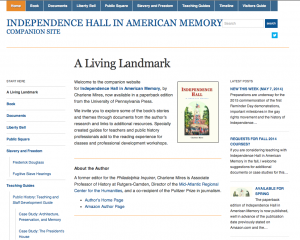A monograph goes public
02 June 2014 – Charlene Mires
 I remember well the day that I received my first copy of my first book, Independence Hall in American Memory. I picked it up in person from the offices of the University of Pennsylvania Press and could barely manage the walk home because of the temptation to stop, admire the beautiful dust jacket, open those pages, smell that new-book smell, and read. Every page contained memories of places, people, and experiences of piecing together a history that spanned more than two hundred years in a building’s life and nearly a decade of mine.
I remember well the day that I received my first copy of my first book, Independence Hall in American Memory. I picked it up in person from the offices of the University of Pennsylvania Press and could barely manage the walk home because of the temptation to stop, admire the beautiful dust jacket, open those pages, smell that new-book smell, and read. Every page contained memories of places, people, and experiences of piecing together a history that spanned more than two hundred years in a building’s life and nearly a decade of mine.
With that book, first published in 2002, I achieved tenure and promotion, and I was pleased to generate some new conversation about the long history of a landmark most commonly associated with the Declaration of Independence and the Constitution. But while the monograph opened some doors (and perhaps some minds), it also carried with it some inherent limitations.
Ironically enough for a book dealing with public history, it was going to be difficult for the public to gain access to the work. Part of this was simply the price of the hardcover book, which started at $34.95 but escalated over time to $47.50. And ironically enough for a book about a structure, the architecture of the monograph itself presented challenges for some readers. While my introduction delved into scholarly literature and proposed a model for understanding the role of buildings in constructing public memory, readers or onsite interpreters looking for good stories needed to jump ahead to find them. Even the best stories appeared briefly in the book, while the very rich documents behind them remained stored away in my files.
Fast-forward to 2014. Independence Hall in American Memory is finally available in paperback with a companion website (http://independencehall-americanmemory.com) to make the work more accessible for teachers, interpreters, and the public. Websites are of course much easier to build today than they were at the time when my book was first published. I had help from Stephanie Brown at the University of Pennsylvania Press, who created the WordPress website, and then I populated it with all those things that I wished had been more accessible all along. First I consulted with two of the ranger interpreters at Independence National Historical Park, Renee Albertoli and Bill Caughlan, to ask what they would most like to see. From them came the suggestions for highlighting the fugitive slave hearings that took place in Independence Hall in the 1850s, for providing information about protests and demonstrations in and around the building, and for a timeline for ready reference. Along with this valuable advice, Christian Higgins and Andrea Ashby at the park’s Library and Archives offered their partnership in helping to locate and provide illustrations.
I wrote two teaching guides for publication on the website–one specifically for public history teaching and professional development and the other for US history courses. Similar to the teaching companions often available with textbooks, these include chapter summaries, discussion questions, and active-learning activities for classes or staff development workshops. The website also has allowed me to extend beyond the original content of the book. For example, it hosts a step-by-step case study of the President’s House site in Philadelphia, which after the book’s publication became a matter of controversy related to the presence of slavery in George Washington’s household. Throughout the website are links to documents, many of them transcribed from my research files.
The site is and will remain a work in progress, especially in the documents section (and I welcome suggestions as to what would be most useful). But I am confident enough in this approach that I am beginning to do the same with the companion site for my more recent book, Capital of the World: The Race to Host the United Nations. It’s an indication of the changing nature of publishing that this book had a website from the start (http://capital-of-the-world.com), built in WordPress by Jodi Narde at NYU Press and then turned over to me for management. It began as a blog, which I kept up for about the first year after publication, but it is now evolving into a site with teaching guides and documents. (If you’d like to see if your hometown was in the running to become the Capital of the World in 1945-46, also check out the surprising list of contenders.) Like the Independence Hall site, I hope this will add public value to the work, in this case to spur conversation about place-making and intersections of local and global identities.
Perhaps websites such as these are one approach to building bridges between the expectations of the academy and our commitments as public historians. I welcome suggestions for ways to continue to make this work useful to teaching, training, and practice in public history.
~Charlene Mires is a former editor for the Philadelphia Inquirer and is Associate Professor of History at Rutgers-Camden, Director of the Mid-Atlantic Regional Center for the Humanities, and co-recipient of the Pulitzer Prize in journalism.



